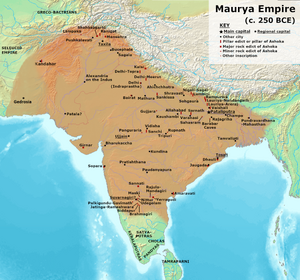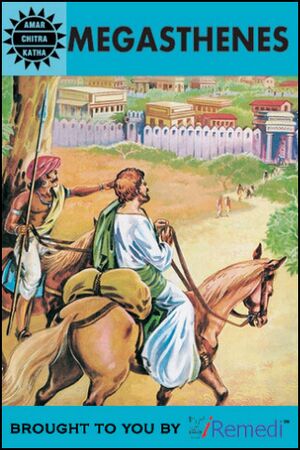Jat clans mentioned by Megasthenes
| Author:Laxman Burdak, IFS (R) |


Megasthenes (ca. 350 BC - 290 BC) was a Greek traveller and geographer. He was born in Asia Minor and became an ambassador of Seleucus I of Syria to the court of Sandrocottus (Chandragupta Maurya) of India, in Pataliputra. However the exact date of his embassy is uncertain. It is believed that he remained at the Maurya capital for about seven years. Scholars place it before 298 BCE, which was the date of Chandragupta's death.
We have more definite information regarding the parts of India which Megasthenes visited. He entered the country through the district of the Pentapotamia of the rivers of which he gave a full account (thought to be the five affluents of the Indus, forming the Punjab region), and proceeded from there by the royal road to Pataliputra. There are accounts of Megasthenes having visited Madurai (then, a bustling city and capital of Pandya Kingdom), but appears not to have visited any other parts of India.
Indica
Megasthenes was sent with the Plataean Deimachus, by Seleuous Nicator, the king of Syria and one of Alexander's generals, as ambassador to Sandracotus, king of the country near the Ganges. He wrote a very valuable account of India in four books.[1]
His observations were recorded in Indica, a work that served as an important source to many later writers such as Strabo and Arrian. He describes such features as the Himalayas and the island of Sri Lanka.
Jat clans mentioned by Megasthenes
Megasthenes also described India's caste system and a number of clans out of these some have been identified with Jat clans by the Jat historians. Megasthenes has mentioned a large number of Jat clans. It seems that the Greeks added 'i' to names which had an 'i' ending. Identified probable Jat clans have been provided with active link within brackets. (See Jat clans mentioned by Megasthenes)
| Jat clans as described by Megasthenes | ||||||||||||
| Location | Jat clans | Information | ||||||||||
|---|---|---|---|---|---|---|---|---|---|---|---|---|
| 1. From the chain of Emodus
|
Are the Isari (Isran, Isram, Asra[2]), Cosyri (Kasya), Izgi (Igia)
|
| ||||||||||
| 2. On the hills
|
The Chisiotosagi, and the Brachmauae
|
The Brachmauaea name comprising many tribes, among which are the Maccocalingae | ||||||||||
| 3. Ganges
|
The Mandei (Munda/Manda), and the Malli (Malli), the Gangarides (Ghangas+Rad), the Calingae (Kalinga), the Prasii (Magadha), the Modogalingae
|
The tribes called Calingae (Kalinga) are nearest the sea, and higher up are the Mandei (Munda/Manda), and the Malli in whose, country is Mount Mallus, the boundary of all that district being the Ganges.
| ||||||||||
| 4. Beyond these | the Modubae (Muwal, Musa), Molindae, the Uberae (Shiwar) with a handsome town of the same name, the Galmodroesi, Preti, Calissae, Sasuri, Passalae, Colubae, Orxulae, Abali, Taluctae (Tamluk) | The king of these keeps under arms 50,000 foot-soldiers, 4,000 cavalry, and 400 elephants | ||||||||||
| 5. Next come | The Andarae (Andar, Andari, Andhras) | A powerful race, which possesses numerous villages, and thirty towns defended by walls and towers, and which supplies its king with an army of 100,000 infantry, 2,000 cavalry, and 1,000 elephants | ||||||||||
| 6. Next | The Dardae (Dara, Darad, Darar, Daral), the Setae (Set, Seti) | Gold is very abundant among the Dardae (Darad), and silver among the Setae (Set) | ||||||||||
| 7. Next | The Prasii (Magadha) | Prasii surpass in power and glory every other people, not only in this quarter, but one may say in all India, their capital Palibothra, a very large and wealthy city, after which some call the people itself the Palibothri,--nay even the whole tract along the Ganges. Their king has in his pay a standing army of 600,000 foot-soldiers, 30,000 cavalry, and 9,000 elephants | ||||||||||
| 8. After these, but more inland | Are the Monedes (Moond) and Suari (Soora, Sheoran) | In those country is Mount Maleus; The river Jomanes flows through the Palibothri into the Ganges between the towns Methora (Mathura) and Carisobora (Krishnapura). | ||||||||||
| 9. The hill-tribes between the Indus and the Iomanes | The Cesi (Kes, Khasa); the Cetriboni (Khatri), the Megallae (Magloda, Mogal , Mogial, Mokar, Mukul), the Chrysei (Karesia, Khar, Karusha), the Parasangae (Paras , Paraswal), and the Asange (Ashvigam, Sange, Sangwa, Samachi ) | The Megallae, whose king is master of five hundred elephants and an army of horse and foot of unknown strength;The force under arms consists of 30,000 foot, 300 elephants, and 800 horse the Asange, where tigers abound, noted for their ferocity | ||||||||||
| 10. Below the deserts are | The Dari (Dar, Dara, Darwal), the Surae (Sur, Sauran, Soora, Surve), the Maltecorae (Maltiya), Singhae (Sangha, Singa, Singad, Singala, Singhal, Singhar, Singwa), Marohae (Marhal, Maru, Maurya, Marohi), Rarungae (Rangi, Ranjha, Rara), Moruni (Mor) | These inhabit the hills which in an unbroken chain run parallel to the shores of the ocean. They are free and have no kings, and occupy the mountain heights, whereon they have built many cities | ||||||||||
| 11. Next | The Narae (Nehra) | Enclosed by the loftiest of Indian mountains, Capitalia. The inhabitants on the other side of this mountain work extensive mines of gold and silver. | ||||||||||
| 12. The inhabitants on the other side of this mountain | The Oraturae (Aratta, Ora, Rathor) | Whose king has only ten elephants, though he has a very strong force of infantry | ||||||||||
| 13. Next again
|
The Varetatae (Vijayrania) | Subject to a king, who keep no elephants, but trust entirely to their horse and foot | ||||||||||
| 14. Then | The Odomoboerae (Odasi); the Salabastrae (Salaru, Arab, Salar , Saliyawas, Syal); the Horatae (Haratwal, Hora) | The Horatae, who have a fine city, defended by marshes which serve as a ditch, wherein crocodiles are kept, which, having a great avidity for human flesh, prevent all access to the city except by a bridge. And another city of theirs is much admired--Automela, which, being seated on the coast at the confluence of five rivers, is a noble emporium of trade. The king is master of 1, 600 elephants, 150,000 foot, and 5,000 cavalry. The poorer king of the Charmae (Chahar has but sixty elephants, and his force otherwise is insignificant | ||||||||||
| 15. Next come | The Pandae (Pander, Pandel , Pandya) | The only race in India ruled by women. They say that Hercules having but one daughter, who was on that account all the more beloved, endowed her with a noble kingdom. Her descendants rule over 300 cities, and command an army of 150,000 foot and 500 elephants | ||||||||||
| 16. Next | With 300 cities, the Syrieni (Saharan), Derangae (Dengri, Dara), Posingae (Poshak, Pasang), Buzae (Bajya, Bojak, Bozdar, Buta), Gogiarei (Gugar, Godara, Gogar, Khokhar), Umbrae (Unvarwal), Nereae (Nehra), Brancosi (Baran, Bharangar), Nobundae (Nawad), Cocondae (Kookana), Nesei (Nashier), Pedatrirae (Penda, Palasia), Solobriasae, Olostrae (Ojlan) | Who adjoin the island Patale, from the furthest shore of which to the Caspian gates the distance is said to be 1, 925 miles | ||||||||||
| 17. Then next to these towards the Indus come, in an order which is easy to follow | The Amatae (Antal, Mata), Bolingae (Balyan, Bhular, Bolan), Gallitalutae (Gahlot, Galati), Dimuri (Dammar), Megari (Maukhari), Ordabae (Buria), Mese (Matsya) | |||||||||||
| 18. After these
|
The Uri (Uria) and Sileni (Sel, Salakalan)
|
Immediately beyond come deserts extending for 250 miles. | ||||||||||
| 19. Immediately beyond come deserts extending for 250 miles. These being passed | We come to the Organagae (Ahervanshi), Abaortae (Afridi), Sibarae (Sibia/Sagari, Sipra), Suertae (Suriara)
|
And after these to deserts as extensive as the former.
| ||||||||||
| 20. Then
|
Come the Sarophages, Sorgae, Baraomatae, the Umbrittae, and the Aseni (Ashvayana) | The Umbrittae, who consist of twelve tribes, each possessing two cities. and the Aseni, who possess three cities. Their capital is Bucephala, built where Alexander's famous horse of that name was buried | ||||||||||
| 21. Inhabiting the base of Caucasus | The Soleadae (Solath), and the Sondrae (Sunda, Sontra, Sandhran) | |||||||||||
| 22. If we cross to the other side of the Indus and follow its course downward we meet the
|
Samarabriae (Samara, Samaria, Samarwal, Samra), Sambruceni (Sambar, Samota), Bisambritae (Bisarnia), Osii (Bassi, Vashi), Antixeni (Antil, Antas), and the Taxillae (Taxak, Tokas) with a famous city (Taxila)
|
| ||||||||||
| 23. Then succeeds a level tract of country known by the general name of Amanda (Manda)
|
The Peucolaitae (Panghal), Arsagalitae (Asiagh), Geretae (Jarta/Getae), Asoi (Asiagh)
|
Whereof the tribes are four in number
| ||||||||||
| 24. Beyond Indus
|
Four satrapies, --the Gedrosi (Gadar), Arachotae (Arak), Arii (Aria, Herat), Paropamisadae (Kabul valley)
|
Making the river Cophes (Kabul) its furthest limit; though others prefer to consider all these as belonging to the Arii (Aria) | ||||||||||
See also
- The Anabasis of Alexander by Arrian
- Megasthenes-Indika
- Jat clans mentioned by Pliny
- Natural History by Pliny Book VI/Chapter 23
References
- ↑ The Anabasis of Alexander/5a, Ch.5, f.n.3
- ↑ Bhim Singh Dahiya: Jats the Ancient Rulers (A clan study)/Porus and the Mauryas, p.167, s.n.5
Back to Books on Jat History

